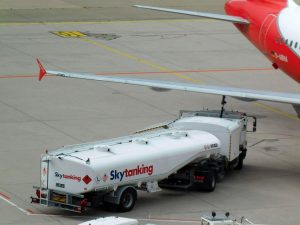The aviation industry is heading towards a substantial supply gap with green kerosene and is therefore in danger of missing its climate targets. This emerges from the study “From Feedstock to Flight: How to unlock the potential of SAF” by Strategy&, PwC’s global strategy consultancy. As early as 2030, the industry could need around 46 million tons of so-called Sustainable Aviation Fuel (SAF) worldwide in order to meet regulatory requirements and its own goals on the way to Net Zero.
However, at the current rate of expansion of the necessary infrastructure and refineries, according to calculations by the International Air Transport Association (IATA), a maximum of 2030 million tons of SAF can be produced in 24, which corresponds to a gap of 22 million tons of SAF - i.e. almost 50% of the requirement. In order to close this gap and still achieve its climate goals, the industry would have to invest at least 2030 billion euros by 100, according to the Strategy& study. By 2035, the investment requirement will rise to 215 billion euros, and by 2050 it will be more than 1.000 billion euros.
The aviation industry is heading towards a huge supply gap for Sustainable Aviation Fuels (SAFs).
- As early as 2030, there could be a global shortage of around 22 million tons of SAF - roughly as much as can be produced in the same year
- In order to cover its SAF needs, the industry would have to invest around 2030 billion euros by 100
- In addition to the production of SAF from organic waste, production from hydrogen is becoming increasingly relevant
- To achieve their climate goals, all stakeholders are asked to act in a coordinated manner and invest massively
SAF essential for green aviation
Aviation currently contributes around 2,5% to global CO2 emissions. However, the industry wants to operate CO2050-neutrally by 2. In order to achieve this goal despite increasing air traffic, many airlines rely on SAFs - a collective name for biological and synthetic fuels that can also be used to fuel conventional aircraft and save 66-94% of CO2 emissions. A distinction is made between several SAF types, with two types being examined in more detail in the study. HEFA-SAF (Hydrotreated Esters and Fatty Acids) is obtained from organic waste, oils and lipids and can already be produced in larger quantities, while PtL-SAF (Power-to-Liquid) is based on hydrogen and saves more emissions, albeit technically is also less mature so far and will probably be significantly more expensive. Aviation needs large quantities of both types for its climate goals. Regulatory quotas also apply: for example, fuel at EU airports must contain at least 2030% SAF by 6. Japan requires a 2030% SAF share for international flights by 10. In addition, according to the study, in order to achieve the net zero target, 100-200 SAF refineries would have to start operations by 2030.
“Green kerosene is currently the only economically viable technology to enable more climate-friendly flying. However, for a variety of reasons, the industry is lagging behind its own requirements and regulatory requirements when it comes to expanding the necessary infrastructure and ramping up production capacities,” says Dr. Jan H. Wille, co-author of the study and partner at Strategy& Deutschland and PwC Aerospace and Defense Leader in the EMEA region. “We are currently observing enormous uncertainty among all players, for example with regard to future regulations, reporting and accounting, but also the availability of the required starting materials as well as the scalability of production technologies and the issue of investment security. At the same time, a certain inertia in decision-making has crept in because everyone is waiting for the steps of the other actors and the political regulations before they get started themselves.”
Out of the supply gap in five steps
To overcome these hurdles, the study proposes a five-part action plan that applies to both SAF types. First, the industry should demonstrate the scalability of the refineries, for example through successful pilot plants. It is also about ensuring the supply of the raw materials required for SAF production. In the case of HEFA-SAF, this primarily concerns organic waste; in the case of PtL-SAF, this mainly concerns large amounts of cheap renewable energy and CO2. Thirdly, financial risks can be minimized on this basis, for example through subsidies or cooperation models. International standards, clear regulatory requirements and globally recognized SAF certification are further important steps. Finally, the industry must convince the public of the benefits of the technology.
“Aviation is currently facing a similarly profound transformation as the automotive industry. In the coming decades, completely new value chains and business models with enormous growth opportunities will also develop here. “It starts with the collection and processing of organic waste, continues through the manufacture of refinery equipment and all the way to SAF dealers,” says Dirk Niemeier, co-author of the study and director at Strategy& Deutschland. “There are great opportunities for providers entering the market now: Given the SAF supply gap, the emerging quotas and the resulting growing demand, the market is expected to continue to develop as a seller's market that can enable producers to make high margins. However, for this new SAF ecosystem to develop, it requires a rapid and concerted effort from all stakeholders, driven by a shared vision and a pinch of pragmatism. This also includes openly addressing possible negative effects, such as the misuse of food to produce organic waste for SAF production, and preventing them as early as possible.”




